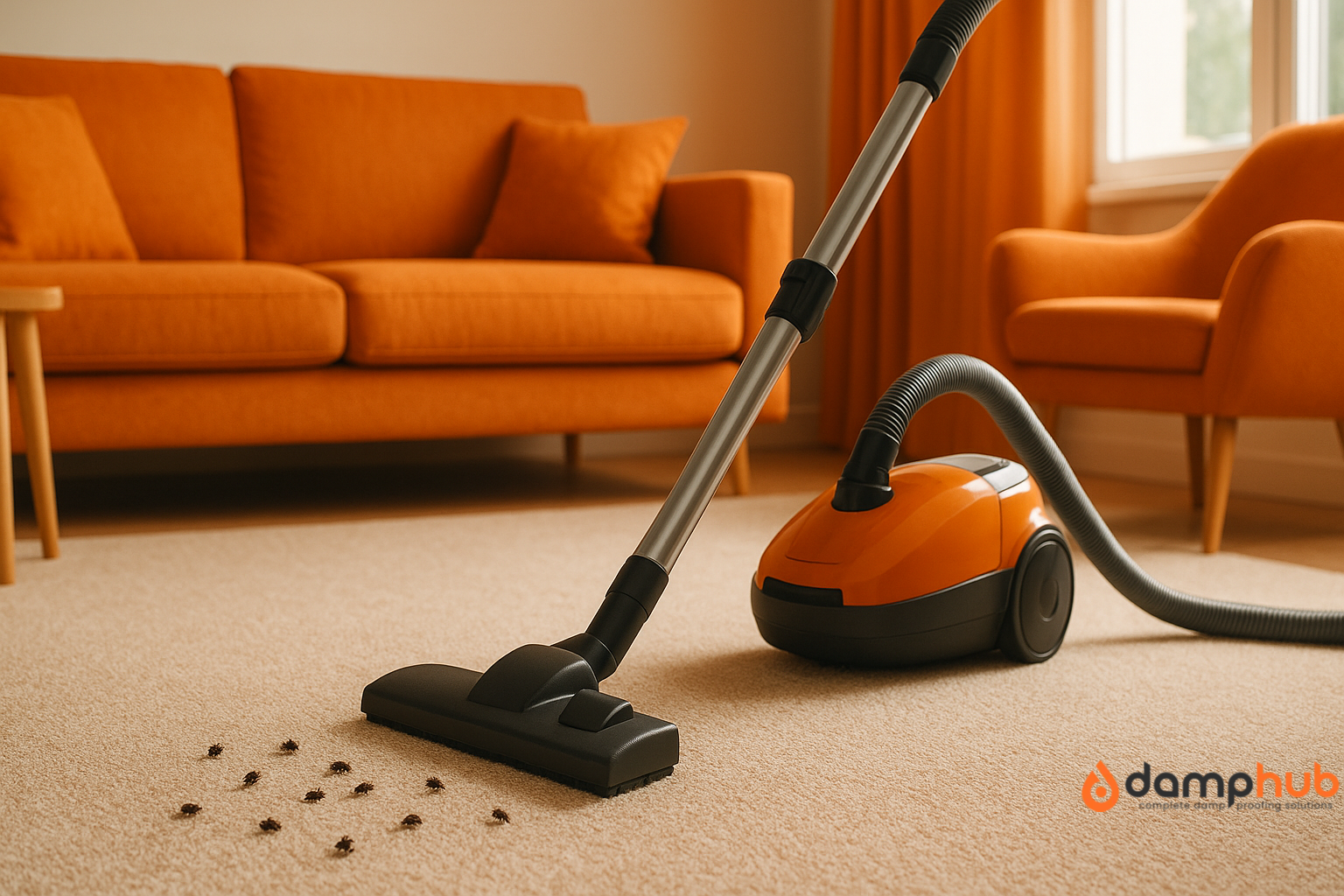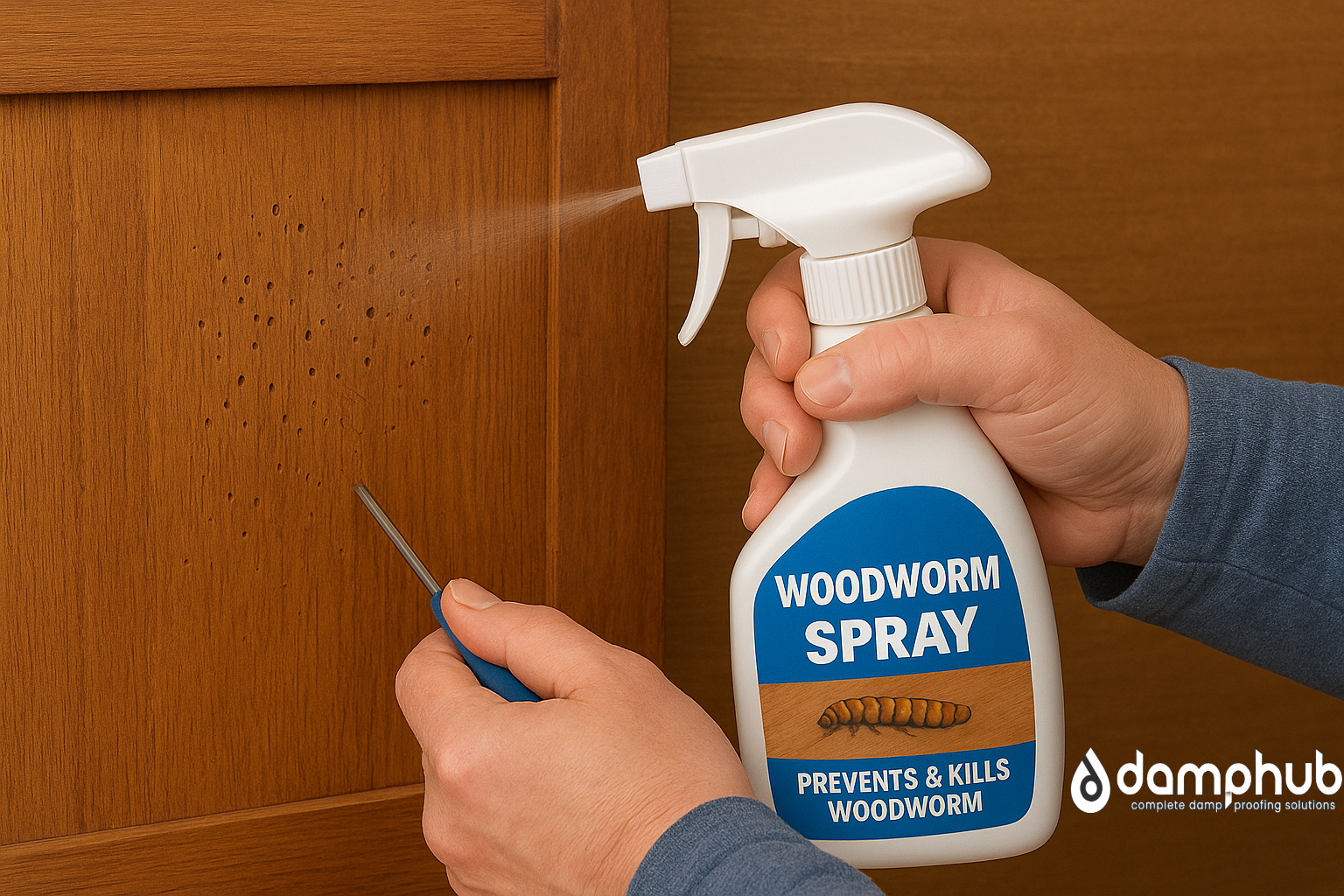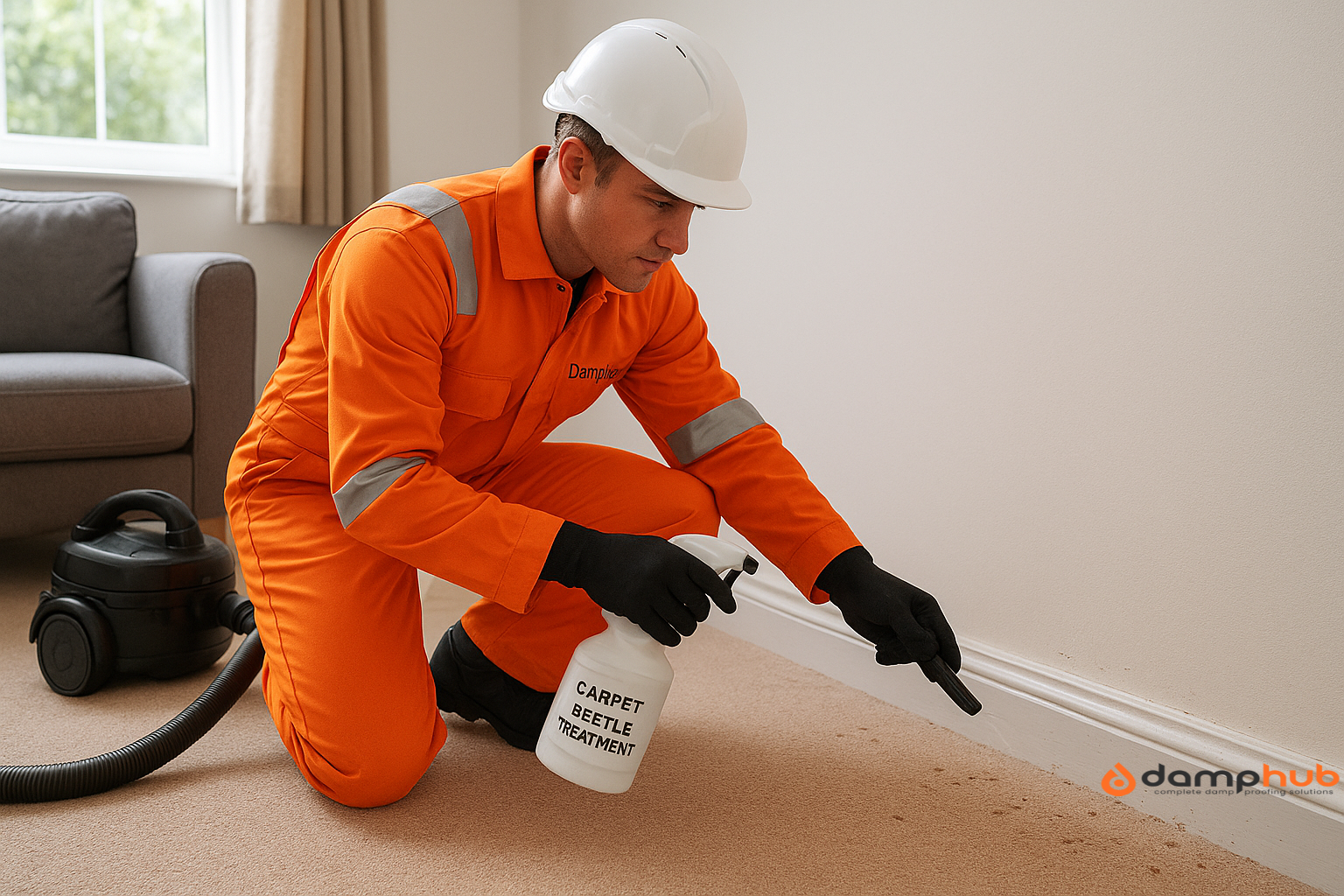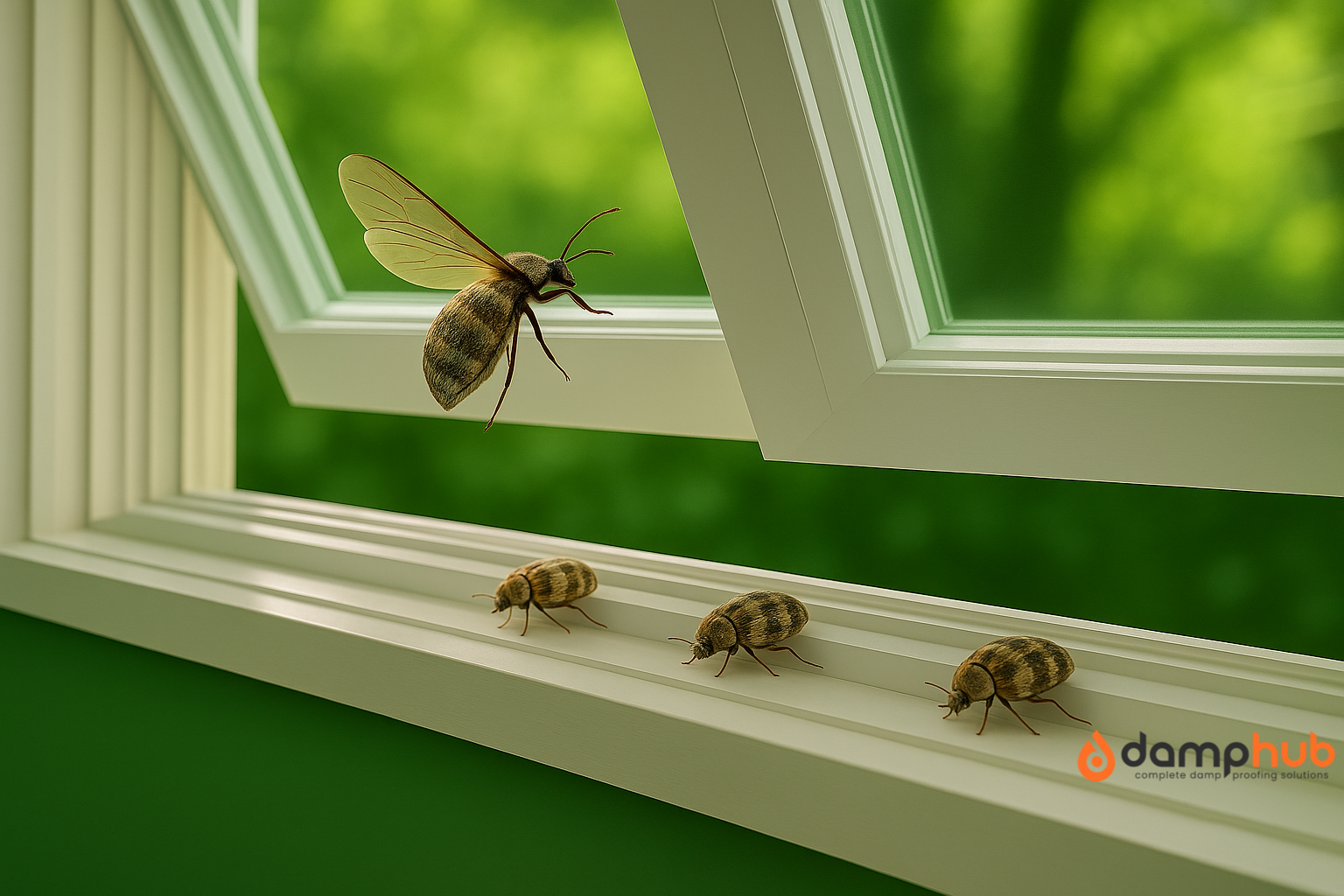
Carpet beetles are a nightmare most people don’t see coming. One week you’re dealing with a few mysterious holes in your pullover, the next you’re realising larvae are buried in your carpets, furniture, or loft insulation. At that point, the temptation is to Google “professional carpet beetle extermination near me” and click the first name with a cheap price tag.
However, be warned that the cheaper choice may ultimately cost you more. A quick spray and a handshake rarely cut it. The beetles will be back, and they don’t wait long to multiply. If you want the infestation dealt with properly, you need to know what separates a trustworthy pest control company from a cut-price operator.
Below, we’ll walk through the essential things to look for in a professional carpet beetle extermination service, the questions worth asking before you book, and how to weigh up value versus cost. Think of it as your roadmap to avoiding wasted money and repeat infestations.
But first, you may want to read our broader coverage on carpet beetles: Carpet Beetles In The UK: Identification, Prevention & Treatment Guide
1. Consider their Accreditation and Training
This is where you start. A professional pest control company should be part of either the British Pest Control Association (BPCA) or the National Pest Technicians Association (NPTA).
Why this matters:
- Proper qualifications. You’re not getting a “bloke with a spray can,” you’re getting someone who understands insect biology and safe treatment methods.
- Consistent standards. Membership means their work is checked, so you don’t get rogue shortcuts.
- Approved products. They’ll use insecticides that are safe for use inside UK homes.
Cheaper operators sometimes reach for products that shouldn’t be used indoors. Strong? Yes. Effective? Maybe for a week. Safe and lasting? Absolutely not.
2. Know their Carpet Beetle Treatment Methods
Carpet beetles aren’t easy to shift because they live in different stages (eggs, larvae, and adults), often tucked away in places you rarely see. That’s why the treatment method a company uses really matters. A quick spray might knock down a few visible beetles, but it won’t touch eggs in the loft insulation or larvae hidden deep in carpet fibres. Unless all stages are targeted, the problem simply comes back.
A competent pest removal service will usually employ a tailored carpet beetle treatment plan, often combining methods such as:
- Residual insecticides — applied to carpets, skirting boards, and furniture edges. These keep working over time, killing larvae as they move across treated surfaces.
- ULV fogging — an ultra-fine mist that penetrates lofts, wall voids, and tucked-away spaces where beetles hide.
- Heat treatment — especially effective for black carpet beetles, which can shrug off sprays. Industrial-grade heating wipes out eggs, larvae, and adults in one go.
- Integrated Pest Management (IPM) — the gold standard. This combines treatment with prevention: sealing cracks, removing bird nests from lofts, and giving clear storage and cleaning advice.
With all these, proper carpet beetle extermination isn’t about what’s fastest for them — it’s about matching the right mix of tools to the specific infestation in your home.
Carpet Beetle Treatment Methods — Comparison
| Method | How it Works | Best For | Pros | Cons |
|---|---|---|---|---|
| Residual Insecticides | Applied to carpets, skirting boards, and furniture edges; kills larvae as they move across treated surfaces. | General infestations in accessible areas. | Long-lasting effect; easy to target key areas. | Requires careful application; may not reach hidden spaces. |
| ULV Fogging | Ultra-fine mist penetrates lofts, wall voids, and tucked-away hiding spots. | Hard-to-reach areas where beetles hide. | Reaches hidden spaces; fast coverage. | Limited residual effect; may need repeat treatment. |
| Heat Treatment | Industrial-grade heating eliminates eggs, larvae, and adults in one go. | Black carpet beetles or infestations resistant to sprays. | Kills all life stages at once; chemical-free. | Can be costly; requires specialist equipment. |
| Integrated Pest Management (IPM) | Combines treatment with prevention: sealing cracks, removing bird nests, storage and cleaning advice. | Long-term prevention and comprehensive control. | Addresses root causes; reduces future risk; eco-friendly. | Requires ongoing effort; results take time to be noticeable. |
3. Ask About Insurance Cover
When you invite a pest control company into your home, you’re trusting them to use strong chemicals and heavy equipment around your belongings. Most of the time, nothing goes wrong, but if it does, the damage can be costly. Imagine discovering a chemical stain on your wool rug or finding your wooden floor warped after treatment. Without public liability insurance, you’d be left to cover the repair or replacement yourself.
That’s why insurance cover isn’t just a box to tick — it’s your safety net. A reputable company will confirm its policy straight away, and many are happy to show proof if you ask. If a provider hesitates, avoids the question, or downplays it, take that as a clear warning sign.
4. Compare the Carpet Beetle Extermination Costs
It’s tempting to jump on the first pest control company you find, especially when you’re stressed about creepy crawlies in your carpets. But taking a moment to compare costs can save you from bigger headaches down the line. Price isn’t just about the bottom line — it often reflects the quality of service, the safety of the chemicals used, and whether the company stands behind their work.
Some exterminators might dangle a rock-bottom price, but that often means a quick spray-and-go job with no follow-up. The beetles may disappear for a week or two, only to come back stronger — leaving you to pay for treatment all over again. On the other hand, a company that charges a bit more may include a full inspection, multiple visits, and a guarantee that keeps your home protected long-term.
You’re also comparing more than just money. You’re weighing peace of mind.
Expect to see figures in this range:
- Inspection: £50–£100
- Single treatment: £90–£200 per room/area
- Package with follow-ups: £150–£400+
5. Consider Local Knowledge
Carpet beetle infestations don’t follow a single pattern. What attracts or shelters them in one part of the country might be completely different somewhere else. That’s why hiring a technician who knows your local area isn’t just a nice bonus — it can make the treatment far more effective.
Take London, for example. In older terraced houses, carpet beetles often sneak in from bird nests hidden in loft insulation or shared roof voids. A local pest controller who’s worked those kinds of properties before will head straight to the usual hiding spots, rather than wasting time searching at random.
By contrast, in newer suburban estates, it’s far more common for beetles to drift in through vents or poorly sealed windows. A technician familiar with those build styles will know to check air bricks, ducting, and other entry points that an outsider might overlook.
This kind of insight doesn’t just save time — it can save you money, too. A well-informed exterminator gets to the root of the problem faster, which means fewer call-outs, less disruption, and a much lower chance of the beetles coming back.
6. Aftercare and Prevention Advice
Treatment is only half the job. You’ll want clear, practical prevention steps too. The best companies will walk you through things like:
- Hoovering skirting edges and corners regularly.
- Washing woollens on a hot cycle or taking them to the dry cleaner.
- Storing clothes in sealed plastic tubs instead of cardboard.
- Checking lofts or eaves for bird nests.
If they don’t give you advice at the end, then they’re not serious about solving the problem long-term.

7. Speed and Availability
Carpet beetle infestations don’t sit still. What begins as a few insects in one room can spread into wardrobes, lofts, or spare bedrooms within weeks — and the longer they’re left, the harder (and pricier) they are to clear. That’s why availability isn’t just a nice extra; it’s part of the treatment itself.
Some companies are booked solid for weeks, leaving you stuck while the beetles get comfortable. Others can attend within days or even offer emergency call-outs. Local technicians often have more flexibility, too, meaning faster response times and easier follow-ups.
When you’re comparing providers, don’t just ask about price or method — ask how soon they can start. A prompt visit can be the difference between a quick fix and a drawn-out, costly battle.
8. Guarantees
Carpet beetle treatments aren’t always a one-and-done fix. Eggs can hatch weeks later, or beetles might creep in again from a hidden source you didn’t know about. That’s where a guarantee makes all the difference. A reliable company will back their work with a clear safety net — often 30, 60, or even 90 days — meaning if the beetles reappear within that time, they’ll return and treat again without charging you extra.
If a provider refuses to offer any guarantee at all, that should raise a question: are they confident in their methods, or are they more interested in moving on to the next job?
Final Word
Carpet beetles aren’t just a minor nuisance. Left unchecked, they’ll quietly destroy natural fibres in carpets, furniture, and clothing — and by the time you notice, the damage is often done. Picking the right extermination service isn’t about who’s cheapest on Google; it’s about who’s properly trained, insured, and committed to solving the problem for good.
If you weigh up the points above, you’ll avoid the cowboys and find a service that actually clears the beetles — and keeps them from coming back.
Choosing Carpet Beetle Extermination Services in the UK: Common Questions Answered

-
How long does a professional carpet beetle extermination take?
There isn’t one solid answer. A quick spray in a flat might take less than an hour, while a heat treatment in a big house can require half the day. Most time is spent moving furniture, checking nooks and crannies, and ensuring no corner is missed. You don’t want a ten–minute in-and-out job; thorough beats fast every time.
-
Do I need to leave the house during the carpet beetle extermination process?
For chemical sprays or fogging, yes. You’ll usually be asked to head out for a couple of hours until it dries and the air clears. With heat treatments, there’s no chemical residue, but the kit is bulky and runs hot, so you can’t hang around while they work. The technician will give you a straight answer about how long to be out — it’s rarely more than an afternoon.
-
Are carpet beetle treatments safe for children and pets?
That’s probably the first thing most people ask. The short version: yes, if it’s done by someone licensed. They’re using products cleared for homes, which means once they’ve dried, the rooms are safe again. But pets and kids should always be kept away until the technician says it’s fine. Got fish tanks or birds? Mention them up front. There are easy ways to shield them, but only if the technician knows.
-
How many carpet beetle treatments will I need?
Don’t expect miracles in one go. Adults and larvae usually die quickly, but eggs can sit quietly for weeks before hatching. That’s why two visits, sometimes three, are common.
Think of it like weeding a garden: you pull everything you see, but if you don’t go back for the stragglers, they’ll just take over again. A good company will explain the likely schedule before you agree to anything.
-
Will carpet beetle extermination damage my carpets or furniture?
It shouldn’t. The carpet beetle sprays used indoors are made to be safe on common materials, and technicians know to keep away from delicate fabrics. Heat treatment doesn’t stain, but it does mean shifting fragile items out of the way.
Trouble usually comes from unqualified operators using the wrong chemicals. If you’re ever unsure, ask what they’re using and look it up — a reputable company won’t hide the label.
-
How soon will I notice results?
Pretty quickly. You’ll likely see beetles or larvae dead within a few days. But don’t be surprised if more turn up later — that’s often just eggs hatching, not proof the treatment failed. The follow-up visit takes care of those. Clearing carpet beetles is more of a process than a one-off event, and patience pays off.
-
Can I stay carpet-beetle free after professional treatment?
Yes, but you’ve got to play your part. The treatment wipes out what’s there, but prevention keeps them from coming back. That means vacuuming regularly, storing woollens in sealed containers, and checking lofts or eaves for bird nests. None of it is straightforward, but it makes a huge difference. A good exterminator will walk you through the steps — and if they don’t, ask.






